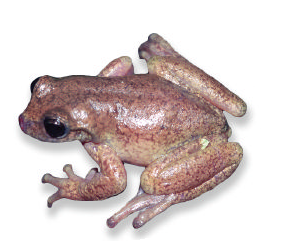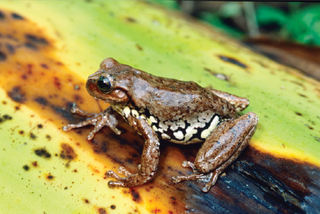
Xenosaurus is a genus of lizards; it is the only extant genus in the family Xenosauridae, with 14 species currently recognized. Also known as knob-scaled lizards, they can found in southwestern Tamaulipas and eastern Guerrero in Mexico. These lizards are known to feed on a variety of crawling and flying insects. This genus mostly eats orthopterans, coleopterans (beetles), dipterans, and myriapods.

Abronia is a genus of lizards in the family Anguidae that is native to Mexico and Central America. The majority of the species are restricted to southern Mexico and Guatemala, but members of the genus occur as far south as Panama. They inhabit forests and woodlands, mostly in highlands, and some species are often associated with bromeliads. They are typically arboreal, but there are also terrestrial Abronia species. Many species are considered threatened due to habitat loss, killing by locals who mistakenly believe they are venomous, or collection for the captive reptile trade. They feed on small animal prey, such as insects, and the females give birth to live young.

The Sierra Madre del Sur is a mountain range in southern Mexico, extending 1,000 kilometres (620 mi) from southern Michoacán east through Guerrero, to the Isthmus of Tehuantepec in eastern Oaxaca.

Sarcohyla bistincta, also known as the Mexican fringe-limbed treefrog or Cope's streamside treefrog, is a species of frog in the family Hylidae. It is endemic to Mexico; it is widespread and occurs from southern Sinaloa and Durango southeastward to Veracruz and Oaxaca. The nominal Sarcohyla bistincta consists of several lineages that may eventually be described as distinct species.

Sarcohyla labeculata is a species of frog in the family Hylidae. It is endemic to the Sierra Mixe in Oaxaca, Mexico. This species was resurrected from synonymy of Sarcohyla bistincta in 2018, while at the same time bringing Sarcohyla calthula and Sarcohyla ephemera in its synonymy. Common name Mixe streamside treefrog has been proposed for this species, whereas the common names yellow-robed treefrog and Cerro Las Flores spikethumb frog referred to the former S. calthula and S. ephemera, respectively.
Sarcohyla celata, also known as the Oaxaca treefrog, is a species of frog in the family Hylidae. It is endemic to Mexico and only known from the Sierra de Juárez in northern Oaxaca. After having not been seen after 1984, it was feared that the species might be extinct. However, the species was rediscovered in field surveys during 2011–2014 and some subpopulations are at healthy levels.
Sarcohyla cembra, also known as the Southern Sierra Madre treefrog, is a species of frog in the family Hylidae. It is endemic to Mexico. Until recently, it was only known from two male specimens: one from its type locality on the Pacific slopes of the Sierra Madre del Sur mountains, Pochutla District, Oaxaca, and another one from Sierra de Yucuyacua south-east of Llano de Guadalupe, in north-west Oaxaca. The two locations are about 172 km (107 mi) apart. After having not been seen after 1993, it was feared that the species might be extinct. However, the species was rediscovered in field surveys in 2011–2012, extending its range with a new locality about 10 km north of the type locality.
Sarcohyla chryses, also known as the golden treefrog, is a species of frog in the family Hylidae. It is endemic to the Sierra Madre del Sur in Guerrero, Mexico. Its sister species is Sarcohyla mykter.
Sarcohyla cyclada is a species of frog in the family Hylidae. It is endemic to the Sierra Madre de Oaxaca of Mexico.

Sarcohyla mykter, also known as the keelsnout treefrog or keel-snouted treefrog, is a species of frog in the family Hylidae. It is endemic to the Sierra Madre del Sur in Guerrero, Mexico. Its sister species is Sarcohyla chryses.
Sarcohyla pentheter, the mourning treefrog, is a species of frog in the family Hylidae. It is endemic to Mexico. Its natural habitats are subtropical or tropical moist montane forests and rivers. Scientists have observed it pine-oak forests on the west side of the Sierra Madre del Sur mountains in Oaxaca between 1,280 and 2,000 meters above sea level.
Sarcohyla siopela, also known as the voiceless treefrog or mute treefrog, is a species of frog in the family Hylidae. It is endemic to Mexico and only known from the west slope of the Cofre de Perote Mountain, in Sierra Madre Oriental, central Veracruz. It is feared that the species might be extinct.
Sarcohyla thorectes, commonly known as Adler's mottled tree frog, a species of frog in the family Hylidae. It is endemic to Mexico. Its natural habitats are subtropical or tropical moist montane forests and rivers. It has been observed in streams between 1530 and 1900 meters above sea level in the Sierra Madre del Sur mountains. It is threatened by habitat loss.
Sarcohyla miahuatlanensis, or the Sierra Miahuatlan spikethumb frog, is a species of frog in the family Hylidae. It is endemic to Mexico and only known from its type locality near Candelaria Loxicha on the Sierra de Miahuatlán in Oaxaca.

Abronia cuetzpali is a species of arboreal alligator lizard described in 2016 by Campbell, Solano-Zavaleta, Flores-Villela, Caviedes-Solís and Frost from the Sierra de Miahuatlán of Oaxaca, Mexico.

Sarcohyla is a genus of frogs in the family Hylidae. It is endemic to Mexico and is found in the montane parts of the country between Durango in the north and Guerrero in the south. These frogs typically occur in pristine habitats along streams in pine-oak woodland at elevations between 1,500 and 3,100 m above sea level. The generic name is derived from the Greek sarkodes meaning "fleshy" in combination with Hylas and refers to the thick, glandular skin characteristic of most of the species in the genus.

Abronia juarezi, also known commonly as the Sierra Juarez alligator lizard and el escorpión de Sierra de Juárez in Mexican Spanish, is a species of lizard in the family Anguidae. The species is endemic to the Sierra Juárez in the state of Oaxaca, Mexico.

Herrera's alligator lizard is a species of medium-sized lizard in the family Anguidae. The species is endemic to Mexico.
Sarcohyla toyota, or Toyota's tree frog is a frog in the family Hylidae, endemic to Mexico. Scientists have seen it in cloud forests in the Sierra Madre del Sur mountains between 1975 and 2185 meters above sea level.
Sarcohyla floresi is a frog in the family Hylidae, endemic to Mexico. Scientists have seen it between 1461 and 2000 meters above sea level.











